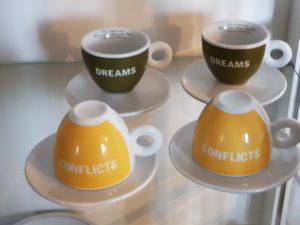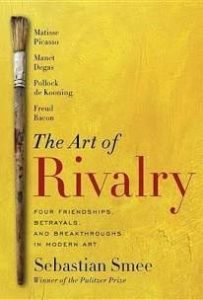 Holidays are a wonderful thing.
Holidays are a wonderful thing.
Not only are they a great opportunity to step outside the obligations and scheduling of daily life, they open the space where the bigger picture lives.
And so it was for me in my lovely apartment at the top of the cliff in Riomaggiore on the Cinque Terre in Italy.
As I stepped inside the front door, the cups in the glass cabinet caught my eye. In my busy overextended life back in Sydney I would have passed by. But here, relaxed and present, I took another look. The visual image of the 4 cups and their messages seemed very symbolic. In this setting, ‘conflicts’ lost its disruptive and destructive force and simply became, along with ‘dreams’ just another element of daily life.
I was immediately reconnected with a favourite text The Magic of Conflict, by the improbably named Thomas Crum and never out of print since first published in 1998.
The nature of conflict
Crum urges us to reframe conflict and abandon our attachment to the myth that conflict is negative – a myth he claims blocks our path to successful resolution. He urges us to see conflict as neither good nor bad – something that just is.
But Crum does not leave it there. He wants us to develop admiration for conflict.
For Crum, conflict is the great catalyst, the key to turning ‘a life of work into a work of art’. He uses storytelling, drawn from his role as an observer of nature, to illustrate how ‘nature uses conflict as a primary motivator for change’.
Back to the cups in the cabinet
Now I understand the message!
The cups of conflict and the cups of dreams are symbolic of creativity – tools that trigger our imagination and ingenuity taking us from the ordinary and the predictable to possibilities that are extraordinary and unique.
A wonderful holiday ‘aha’ moment and this time, unlike holidays past, what happened on the holiday followed me home.
Conflict lessons are everywhere
My book club, comprising a selection of women you would not want to mess with, is known affectionately (and perhaps accurately) as ‘The Coven.’ The book for our next meeting greeted me on my return. Still reflecting on my holiday lesson, I opened the parcel to find The Art of Rivalry, Pulitzer Prize winning author Sebastian Smee’s tribute to the power of conflict.
 Ostensibly a dissection of 4 famous artistic conflicts, the overarching theme is of conflict as a trigger for great innovation. Smee describes Picasso, Freud, de Kooning and Degas as significant beneficiaries of friendships that morphed into conflict as each of the four encountered his ‘more fluent, more audacious peer’.
Ostensibly a dissection of 4 famous artistic conflicts, the overarching theme is of conflict as a trigger for great innovation. Smee describes Picasso, Freud, de Kooning and Degas as significant beneficiaries of friendships that morphed into conflict as each of the four encountered his ‘more fluent, more audacious peer’.
This ‘cauldron of competitiveness’ propelled each beneficiary to a new level of artistic achievement, solidifying their place in art’s hall of fame.
Meanwhile – back at the office …..
My working life is with businesses and the conflicts and challenges experienced by the people that inhabit them. It is a world away from Italian holidays and combative artists – or is it? Fresh from mediating a damaging conflict in a vast media business, I was asked by the CEO to develop a bespoke training program on navigating conflict at work.
The business is full of smart, driven, innovative overachievers who together produce some of the most memorable media experiences in Australia. It was a big ask. I wondered how I might find a way to draw on Crum and Smee that seemed relevant to this challenging business world – far removed from nature and art history.
Another piece of serendipity from the universe saw me dislodge a pile of ‘must re-read’ articles from the Harvard Business Review that were gathering dust in the corner of my office. Into my hand fell ‘Productive Friction,’ the February 2005 article exploring how ‘difficult business partnerships can accelerate innovation’.
Using phrases like ‘creative abrasion’ and ‘productive friction’ the article proposed conflict as the ‘sand in the oyster’ from which the beautiful and valuable pearl emerges.
This was not an isolated article. Exploring the linkage between conflict and creativity in business is a continuing theme among HBR authors and commentators. June 2018 saw an HBR article expanding Smee’s case studies of creative conflict to conflicts across every walk of life and business – from Jobs and Wozniak (whose tensions invigorated Apple), to Merkel and Sarcozy, Europe’s Odd Couple.
Putting these ideas to work.
Joining the dots about what conflict is and how it has value has been a truly reinvigorating experience for me as a conflict professional in search of a good outcome. It has been another reminder that the best ideas appear with many different faces and in unexpected places and there is value in exploring their connectedness.
Clearly more Italian holidays are necessary!
________________________
To make sure you do not miss out on regular updates from the Kluwer Mediation Blog, please subscribe here.



What a great reflection, Rosemary. This framing of conflict resonates with me and I find I use it in my own life – both professionally and personally. I am now eager to read Crum’s work and the articles you have referenced. It also reminded me of the Thomas-Kilmann modes of conflict which explore the idea that collaboration is a form of conflict.